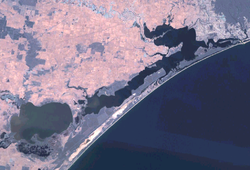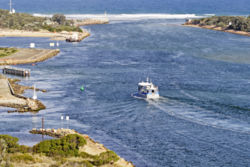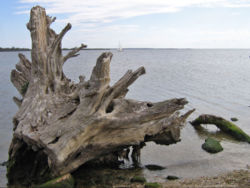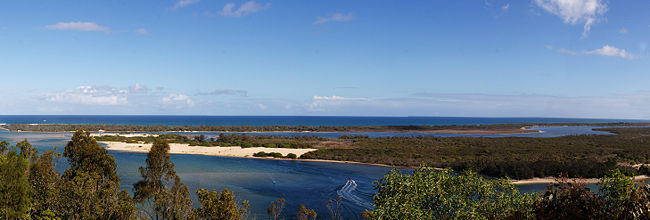
Gippsland Lakes
Encyclopedia



Gippsland
Gippsland is a large rural region in Victoria, Australia. It begins immediately east of the suburbs of Melbourne and stretches to the New South Wales border, lying between the Great Dividing Range to the north and Bass Strait to the south...
, Victoria
Victoria (Australia)
Victoria is the second most populous state in Australia. Geographically the smallest mainland state, Victoria is bordered by New South Wales, South Australia, and Tasmania on Boundary Islet to the north, west and south respectively....
, Australia
Australia
Australia , officially the Commonwealth of Australia, is a country in the Southern Hemisphere comprising the mainland of the Australian continent, the island of Tasmania, and numerous smaller islands in the Indian and Pacific Oceans. It is the world's sixth-largest country by total area...
covering an area of about 600 km2. The largest of the lakes are Lake Wellington (Gunai language
Gunai language
The Gunai language refers to a collection of Indigenous Australian languages from Gippsland in south-east Victoria....
: Murla), Lake King and Lake Victoria. They are fed by the Avon, Thomson, Latrobe
Latrobe River
The La Trobe River is a river in Gippsland, Victoria, Australia. It begins in the area between Powelltown and Noojee where it shares a watershed with the Little Yarra River, a tributary of the Yarra River, and has a number of tributaries joining it from the southern slopes of the Baw Baw plateau,...
, Mitchell, Nicholson
Nicholson River (Victoria)
The Nicholson River is a river in East Gippsland, Victoria, Australia, lying between the Mitchell and the Tambo Rivers. It has a length of .The river was named by Angus McMillan in 1839 after Charles Nicholson, who represented the Port Phillip District on the NSW Legislative Council and was later...
and Tambo
Tambo River (Victoria)
The Tambo River is a river in East Gippsland, Victoria, Australia with a total length in excess of 170 km. It is the longest river in the Tambo and Nicholson Basin, extending from the steep forested southern slopes of the Australian Alps through forest and farmland to the Gippsland...
rivers.
History
The lakes were formed by two principal processes. The first is river deltaRiver delta
A delta is a landform that is formed at the mouth of a river where that river flows into an ocean, sea, estuary, lake, reservoir, flat arid area, or another river. Deltas are formed from the deposition of the sediment carried by the river as the flow leaves the mouth of the river...
alluvial
Alluvium
Alluvium is loose, unconsolidated soil or sediments, eroded, deposited, and reshaped by water in some form in a non-marine setting. Alluvium is typically made up of a variety of materials, including fine particles of silt and clay and larger particles of sand and gravel...
deposition of sediment brought in by the rivers which flow into the lakes. Silt deposited by this process forms into long jettys which can run many kilometres into a lake, as exemplified by the Mitchell River silt jetties
Mitchell River silt jetties
The Mitchell River silt jetties are an unusually long, thin landform located in the Gippsland Lakes region in Victoria, Australia. A type of digitate delta, they have been formed over millions of years by sediment deposition from the Mitchell River during periods of low water flow and subsequent...
that run into Lake King. The second process is the action of sea current in Bass Strait which created the Ninety Mile Beach
Ninety Mile Beach, Victoria
The Ninety Mile Beach is a sandy stretch of south-eastern coastline of Victoria, Australia along the Gippsland Lakes region of East Gippsland on Bass Strait. The beach is just over long running northeastward from a spit near Port Albert to the man-made channel at Lakes Entrance...
and cut off the river deltas from the sea.
Once the lakes were closed off a new cycle started, whereby the water level of the lakes would gradually rise until the waters broke through the barrier beach
Ninety Mile Beach, Victoria
The Ninety Mile Beach is a sandy stretch of south-eastern coastline of Victoria, Australia along the Gippsland Lakes region of East Gippsland on Bass Strait. The beach is just over long running northeastward from a spit near Port Albert to the man-made channel at Lakes Entrance...
and the level would drop down until it equalised with sea-level. Eventually the beach would close-off the lakes and the cycle would begin anew. Sometimes it would take many years before a new channel to the sea was formed and not necessarily in the same place as the last one.
In 1890 a wall was built to fix the position of a naturally occurring channel between the lakes and the ocean at Lakes Entrance, to stabilise the water level, create a harbour for fishing boats and open up the lakes to shipping. This entrance needs to be dredged regularly, or the same process that created the Gippsland Lakes would render the entrance too shallow for seagoing vessels to pass through.
Due to the flooding, in 2011, Gippsland Lakes were experiencing bioluminescence.
Environment
The lakes support numerous species of wildlife and there exist two protected areas within: The Lakes National ParkThe Lakes National Park
The Lakes National Park is a national park in Victoria, Australia, east of Melbourne....
and Gippsland Lakes Coastal Park. The Gippsland Lakes wetlands are protected by the international Ramsar Convention
Ramsar Convention
The Ramsar Convention is an international treaty for the conservation and sustainable utilization of wetlands, i.e., to stem the progressive encroachment on and loss of wetlands now and in the future, recognizing the fundamental ecological functions of wetlands and their economic, cultural,...
on wetlands. There are also approximately 400 indigenous flora species and 300 native fauna species. Three plants, two of them being orchid species, are listed as endangered.
Burrunan dolphins
The lakes are home to about 50 of the recently described species of Bottlenose dolphinBottlenose Dolphin
Bottlenose dolphins, the genus Tursiops, are the most common and well-known members of the family Delphinidae, the family of oceanic dolphins. Recent molecular studies show the genus contains two species, the common bottlenose dolphin and the Indo-Pacific bottlenose dolphin , instead of one...
, the Burrunan dolphin
Burrunan dolphin
The Burrunan dolphin is a recently-described species of bottlenose dolphin found in parts of Victoria, Australia. By size, the Burrunan dolphin is between the other two species of bottlenose dolphin and only around 150 individuals have been found in two locations.-Taxonomy:The species was formally...
(Tursiops australis). The other 150 or so of this rare species are to be found in Port Phillip
Port Phillip
Port Phillip Port Phillip Port Phillip (also commonly referred to as Port Phillip Bay or (locally) just The Bay, is a large bay in southern Victoria, Australia; it is the location of Melbourne. Geographically, the bay covers and the shore stretches roughly . Although it is extremely shallow for...
.
Birds
The wetlands provide habitat for about 20,000 waterbirds – including birds from as far afield as SiberiaSiberia
Siberia is an extensive region constituting almost all of Northern Asia. Comprising the central and eastern portion of the Russian Federation, it was part of the Soviet Union from its beginning, as its predecessor states, the Tsardom of Russia and the Russian Empire, conquered it during the 16th...
and Alaska
Alaska
Alaska is the largest state in the United States by area. It is situated in the northwest extremity of the North American continent, with Canada to the east, the Arctic Ocean to the north, and the Pacific Ocean to the west and south, with Russia further west across the Bering Strait...
. The lakes have been identified by BirdLife International
BirdLife International
BirdLife International is a global Partnership of conservation organisations that strives to conserve birds, their habitats and global biodiversity, working with people towards sustainability in the use of natural resources...
as an Important Bird Area
Important Bird Area
An Important Bird Area is an area recognized as being globally important habitat for the conservation of bird populations. Currently there are about 10,000 IBAs worldwide. The program was developed and sites are identified by BirdLife International...
(IBA) because they regularly support over 1% of the global populations of Black Swan
Black Swan
The Black Swan is a large waterbird, a species of swan, which breeds mainly in the southeast and southwest regions of Australia. The species was hunted to extinction in New Zealand, but later reintroduced. Within Australia they are nomadic, with erratic migration patterns dependent upon climatic...
s, Chestnut Teal
Chestnut Teal
The Chestnut Teal is a dabbling duck found in southern Australia. It is protected under the National Parks and Wildlife Act 1974.-Description:The Chestnut Teal is darker and a slightly bigger bird than the Grey Teal....
s and Musk Duck
Musk Duck
The Musk Duck is a highly aquatic, stiff-tailed duck native to southern Australia. It is the only living member of the genus Biziura. An extinct relative, the New Zealand Musk Duck or de Lautour's Duck , once occurred on New Zealand, but is only known from prehistoric subfossil bones...
s, as well as many Fairy Tern
Fairy Tern
The Fairy Tern is a small tern which occurs in the southwestern Pacific.There are three subspecies:* Australian Fairy Tern, Sterna nereis nereis - breeds in Australia...
s.
Geography
The Gippsland Lakes are, in order of size:- Lake Wellington
- Lake Victoria
- Lake King
- Lake Reeve
- Lake Tyers
- Lake Coleman
External links
- Gippsland Lakes Coastal Park
- Gippsland Coastal Board
- The Lakes National Park & Gippsland Lakes Coastal Park Plan
- Gippsland Ports Authority


